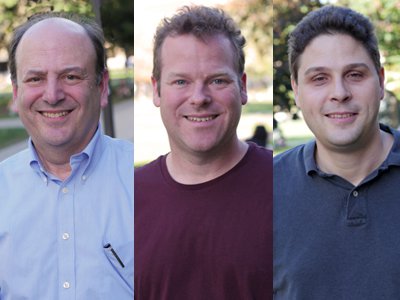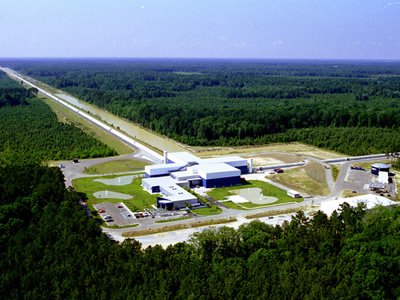LIGO: At a Glance
Everything you need to know about the "Theory of Everything"

Syracuse University is integral to the discovery of gravitational waves, which scientists describe as “ripples in the fabric of spacetime.”
The discovery coincides with 100th anniversary of the publication of Albert Einstein’s Theory of Relativity.
The waves were produced during the collision of two black holes, approximately 1.3 billion ago, resulting in a single black hole.
The discovery is significant for two reasons:
- It opens up a new way of studying the Universe, enabling scientists to infer processes at work that produce gravitational waves; and
- It shows that black holes work the way Einstein had predicted.
The waves in question have been traveling through the Universe, at the speed of light, for more than a billion years. It wasn’t until September 14, 2015, that they reached Earth, and were detected by scientists at LIGO.
LIGO has two identical detectors—1,865 miles apart from one another—that spot tiny vibrations from passing gravitational waves. If a wave passes through one of the detectors (whose tunnels are 2.5 miles long), it subtly stretches space in direction and shrinks it in another.
LIGO scientists use a technique known as interferometry to sense the stretching and shrinking, and, thus, to detect the gravitational wave.
More than two dozen professors, research scientists, and students in Syracuse’s College of Arts and Sciences have been instrumental in the discovery. Chief among them are:
- Peter Saulson, the inaugural Martin A. Pomerantz ’37 Professor of Physics and co-founder of the LIGO Scientific Collaboration (involving nearly a thousand scientists from 15 countries), who first proposed binary star systems as a dominant source of gravitational waves;
- Duncan Brown, the inaugural Charles Brightman Endowed Professor of Physics, who is a leader in the search for black holes with LIGO; and
- Stefan Ballmer, assistant professor of physics, who is a member of the Advanced LIGO design team, and helped build the LIGO Hanford detector in Richland, Wash. (The other LIGO detector is in Livingston, La.)
Syracuse provided significant computing power to Advanced LIGO, utilizing a high throughput environment called Orange Grid and the Crush supercomputer, the latter of which is housed in the Green Data Center on the University’s South Campus.
Syracuse has a long tradition of gravity research excellence, including the following:
- Peter Bergmann, one of Einstein’s research assistants, who taught at the University from 1947 to 1982;
- Emeritus Professor Joshua Goldberg, who carried out one of the first calculations of the emission of gravitational waves by binary stars;
- Research scientist Roy Kerr, a staff member from 1958 to 1960, who went on to discover the solution to the equations of general relativity that describe a spinning black hole; and
- Gabriela González G’95, spokesperson of the LIGO Scientific Collaboration and one of Saulson’s former Ph.D. students.

Black Hole: A place in space where gravity pulls so much that not even light can escape; hence, it is invisible. The black holes whose collision was observed by LIGO were each approximately 100 miles in diameter and contained 30 times the mass of the Sun.
Interferometry: A technique in which a laser beam is split into two parts, which are later recombined. Even a tiny difference in the distance traveled by the two parts can make a huge difference in how bright the beam is, once it recombines. Hence, interferometry is a highly sensitive way to measure small length differences, such as those caused by gravitational waves.
LIGO: An acronym for Laser Interferometer Gravitational-Wave Observatory, a large-scale physics experiment that detects gravitational waves. Funded by the National Science Foundation, LIGO is a joint project between scientists at MIT, Caltech, and many other institutions around the world, including Syracuse. LIGO has observatories in Livingston, La., and Hanford, Wash. Advanced LIGO refers to a five-year upgrade to the first-generation LIGO detectors.
General Theory of Relativity: A mathematical explanation of gravity, which Einstein published in 1915. He argued that matter and energy warped spacetime (a four-dimensional continuum, made up of height, width, depth, and time), thus creating gravity. Einstein argued that gravity was not a force, but a curvature of the spacetime continuum.
Featured
Peter Saulson Professor Emeritus
Duncan Brown Vice President for Research, Syracuse University; Charles Brightman Endowed Professor of Physics
Stefan Ballmer Professor and Director for the Center for Gravitational Wave Astronomy and Astrophysics
Media Contact
Rob Enslin
